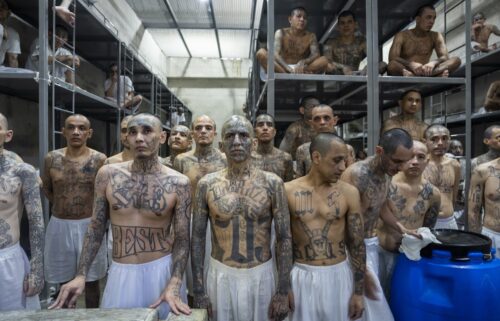The internal jockeying begins as Biden selects his Supreme Court nominee

By Joan Biskupic, CNN legal analyst & Supreme Court biographer
Before the Biden administration engages in any fight with the Senate over the President’s choice for the Supreme Court, there will likely be a brawl within.
President Joe Biden’s allies are already jockeying for attention to their preferences, as seen in House Majority Whip James Clyburn’s forceful support for South Carolina-based US trial Judge Michelle Childs.
Much of the lobbying will be subtler, through back channels and efforts to shape the way that leading contenders are portrayed, in the news media and by those in position to influence Biden.
The President’s advisers are bound to differ to some extent regarding his selection of a historic first Black female justice, and Biden himself may be torn.
RELATED: Breyer’s role on the Supreme Court and the hole he’s leaving
It took President Bill Clinton three months to settle on Ruth Bader Ginsburg for his choice in 1993. President George W. Bush in 2005 brushed aside the preference of Vice President Dick Cheney when he chose John Roberts. And in 2009, President Barack Obama navigated the competing interests of his advisers before he selected Sonia Sotomayor, the country’s first Latina justice.
For a successor to retiring Justice Stephen Breyer, the front-runner appears to be Judge Ketanji Brown Jackson, 51, a former trial judge whom Biden appointed last year to the Washington-based US appellate court that has long operated as a launchpad to the high court. Jackson once served as a law clerk to Breyer.
But the President is exploring a slate of other highly credentialed candidates, including Childs, 55, whom he recently nominated to the same prominent DC Circuit appellate court, and California state Supreme Court Justice Leondra Kruger, 45.
White House chief of staff Ron Klain will be at the center of the selection process and perhaps subject to as much pressure from competing constituencies as Biden. Klain possesses unparalleled experience with the politics of Supreme Court nominations. He served in the Clinton and Obama administrations and helped screen candidates for the high court. Klain also was a chief legal counsel to Biden when the then-senator chaired the Judiciary Committee.
Klain knows the pressures that will confront Biden and the potential influencers, whether members of Congress, close aides or family. Klain, who may have his own preference, would also understand that this could be the President’s only shot at an appointment to America’s highest court.
The selection of a first Black female justice, as Biden pledged Thursday, will make history. But the individual chosen for a lifetime seat may also represent the President’s most enduring legacy.
Bill Clinton’s back and forth
To see past instances of political titans influencing the White House selection process, one could look simply to Clinton’s choice of Breyer in 1994 to fill the seat of retiring Justice Harry Blackmun.
Then-Sen. Ted Kennedy, the powerful Massachusetts Democrat, heavily promoted Breyer, a US appellate judge at the time, for the high court. Breyer had served as a counsel to Kennedy on the Senate Judiciary Committee in the 1970s.
In 1993, Sen. Daniel Patrick Moynihan of New York backed the Brooklyn-born Ginsburg, touting her, as others had, as “the Thurgood Marshall of women’s rights” for her strategic advocacy on women’s legal equality.
Clinton had initially searched for a national figure who transcended the law, in the mold of former California Gov. Earl Warren, who served as chief justice from 1953 to 1969. Clinton turned first to former New York Gov. Mario Cuomo, but Cuomo declined, shunning the cloistered world of the court.
Clinton considered Breyer for that 1993 vacancy arising from the retirement of Justice Byron White, but failed to be persuaded during a reportedly awkward luncheon interview. (Breyer was recovering from a serious bicycle accident at the time. Still on pain medication, he had been hit by a car near his home in Cambridge, Massachusetts, and suffered broken ribs and a punctured lung.)
Ginsburg, then a judge on the springboard DC Circuit, had a place on the Clinton’s shortlist, but the president had rebuffed those asking him to interview her. As improbable as it seems today, given her “Notorious RBG” liberal reputation, some women’s rights advocates quietly opposed Ginsburg’s nomination. Her record on the DC Circuit was not consistently liberal, and she had expressed skepticism for the legal rationale of Roe v. Wade, even as she strongly supported access to abortion.
“The women are against her,” Clinton told Moynihan, according to Moynihan’s account in his personal correspondence at his archive at the Library of Congress.
Moynihan said he countered, “That is your problem, Mr. President. You have too many friends. You cannot govern without enemies.”
White had told Clinton of his impending retirement in mid-March, and by early June Clinton still had not found a nominee who suited him. Attorney General Janet Reno made another pitch for Ginsburg, and Clinton agreed to meet with her. The reserved but persuasive jurist immediately impressed the president, and he publicly announced her nomination the next day.
George W. Bush’s political struggles
More than a decade later, Bush faced competing advice as he weighed his shortlist for an associate justice seat, after Sandra Day O’Connor announced her retirement on July 1, 2005.
Bush wrote in his memoir that he had discussed the choices — narrowed to Roberts, then on the DC Circuit, and fellow US appellate Judges Michael Luttig, on a Richmond, Virginia-based bench, and Samuel Alito, on a Philadelphia-based court — with top advisers Cheney, Attorney General Alberto Gonzales, White House counsel Harriet Miers, chief of staff Andy Card and deputy chief of staff Karl Rove.
“They liked Roberts, but he was not at the top of all lists,” Bush wrote in his book, “Decision Points.” “Dick and Al backed Luttig, who they felt was the most dedicated conservative jurist. Harriet supported Alito because he had the most established judicial record. Andy and Karl shared my inclination toward Roberts.”
Bush then turned to a former top aide: Brett Kavanaugh, whom he had appointed to the DC Circuit.
“Brett told me that Luttig, Alito, and Roberts would all be solid justices. The tiebreaker question, he suggested, was which man would be the most effective leader on the Court — the most capable of convincing his colleagues through persuasion and strategic thinking.”
Bush settled on Roberts for the O’Connor spot in July of 2005 but then switched him to the chief justice vacancy that arose that September when William Rehnquist died.
Kavanaugh himself landed a Supreme Court appointment in 2018, made by then-President Donald Trump and significantly engineered by White House counsel Don McGahn.
For the lingering O’Connor opening, Bush initially chose his White House counsel Miers, a close friend who had had a successful legal practice in their home state of Texas. (First lady Laura Bush had voiced support for a female nominee.) But Miers had scant constitutional law experience.
Conservative heavyweights objected. Robert Bork, a former DC Circuit appellate judge who had been rejected by the Senate for the Supreme Court in 1987, called the Miers nomination “a disaster on every level.”
Miers withdrew after weeks of controversy, and Bush choose Alito — an early favorite of Miers — for the O’Connor seat.
Obama era
Obama’s first opportunity to fill a vacancy arose in 2009, when Justice David Souter retired. Sotomayor, who had been a trial judge and 11-year veteran of the New York-based US appellate court, landed high on the shortlist and was poised to become the first Latina on the Supreme Court.
An array of inside supporters and outside advocates were variously backing Sotomayor and two other finalists, then-US Solicitor General Elena Kagan and US appellate Judge Diane Wood, based in Chicago. First lady Michelle Obama was encouraging Sotomayor’s nomination.
Some Obama aides said it had come down to Sotomayor and Wood; others portrayed it as between Sotomayor and Kagan (who was appointed the following year, when Justice John Paul Stevens retired).
Obama fielded conflicting advice nearly up to the moment he called Sotomayor in late May 2009. After he made the choice and publicly revealed his history-making selection, he crossed paths with Klain, who at the time was then-Vice President Biden’s chief of staff.
As Klain later recounted, he saw relief and satisfaction on Obama’s face.
Said Obama, “I feel really good about this.”
The-CNN-Wire
™ & © 2022 Cable News Network, Inc., a WarnerMedia Company. All rights reserved.


